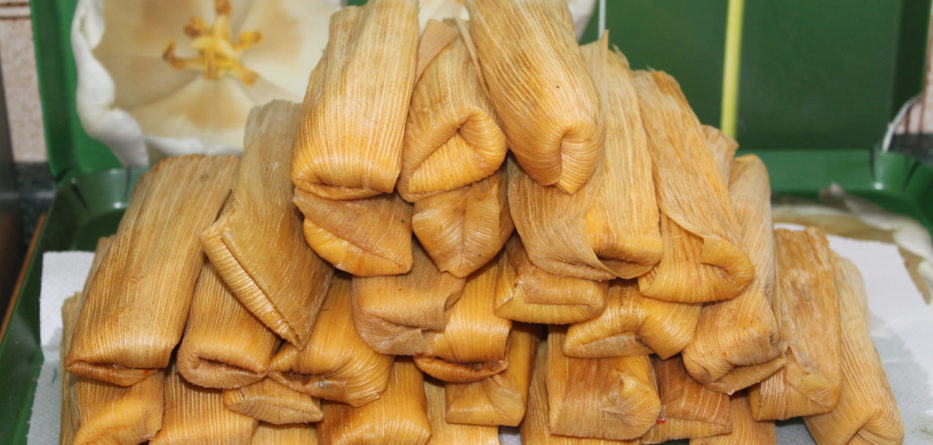Flor Castillo; Translation by Arturo Hilario
EFE
Mérida, Mexico – Tamales, atole, mole, bread, fruits, sweets and drinks will make up many of the offerings that will be assembled by Mexicans in their homes to celebrate the feast of the Day of the Dead, November 1 and 2, to remember what their deceased loved ones feasted on and enjoyed in life.
The varied Mexican cuisine on display has dishes for practically any occasion.
In the state of Yucatan for example, where this past Sunday the Hanal Pixán (the Mayans version of Day of the Dead) festivities began, the stand out cuisine is the mucbipollo a three pound tamale which is cooked in an earthen oven and that is prepared with corn dough, and filled with chicken, pork meat and beans, all wrapped in banana leaves.
The preparation of this ancient food is far from simple. You have to mold the dough, cook the “kool”, a broth dipped in a reddish pigment of achiote, and put all the ingredients into the dough.
“A single person could not [make] the mucbipollos because it is a very laborious work,” explained Silvia Paredes, a traditional cook of this dish, who participated in the festival held in Merida, the Yucatecan capital.
The preparation of this special tamale is a ritual that lasts between four and five hours, because you also have to make a hole in the ground and cook it with wood.
The mucbipollo, which has an ancestral history, is deposited in the offerings dedicated to the dead because it is believed they can enjoy this food when they return to the world of the living during the Day of the Dead.
“It is a pre-Hispanic tradition of all the Maya. We have followed it from generation to generation,” said Paredes, who said the term mucbipollo means “chicken buried in the ground.”
In addition to Yucatan, in the rest of Mexico, tradition dictates that the living “invite” the dead to return and for this they offer dishes, snacks and products that their loved ones enjoyed in life.
From the typical calaveritas (small skulls) made of sugar, amaranth or chocolate, and the traditional Mexican mole, ( a sauce made with chiles and spices), to the pan de muerto (bread of the dead) and various sweets in Mexico, the dead are indulged and entertained by relatives and friends.
Many specialists in gastronomy in Mexico say that the things that cannot be missing in an offering are the traditional pumpkin, papaya, tejocote or sweet potato candy, and the pan de muerto.
The sweets are of pre-Hispanic origin and it is common to find it in public markets and street markets, known as “tianguis”.
The fruits are cooked in clay casseroles with a syrup that is made with brown sugar.
In the case of bread, always round and of different sizes, it is made from a dough – which is left to ferment for more than 24 hours – based on egg, flour, butter, sugar and the unique touch that gives the zest of Orange.
Other meals or dishes in Mexico on the Day of the Dead are traditional tamales, another food of indigenous Mesoamerican origin, which is usually prepared (much like the mucbipollos) with dough and is filled with meat, vegetables, sauces or fruits. These are usually accompanied with atole, a thick, corn and masa based hot beverage.
In the states of Yucatán, Puebla, Michoacán, Oaxaca, Tabasco, State of Mexico and Chiapas, the Day of the Dead is an indigenous holiday which is designated by Unesco as an “Intangible Cultural Heritage of Humanity”.
As shown is the Isthmus of Tehuantepec, in the southern state of Oaxaca, where a type of offering called the Xandu’ is celebrated.
In this, the dead are worshiped in two ways according to the taste of families, using the traditional altars or hanging a bow with banana or cane pennants adorned with flowers, fruits and breads and on the ground, a packed duffel bag is placed featuring all kinds of dishes, sweets and drinks.
In addition to food, water, fruits and sweets used in the popular and ancestral Mexican tradition of Day of the Dead, it is common to see cigarettes and drinks such as tequila or mezcal and products or objects that those ancestors and loved ones imbibed on and generally enjoyed in life on display.






